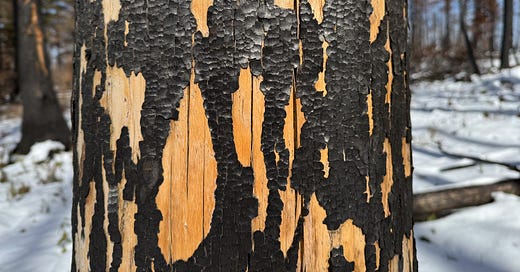Thinning and Logging Aren't a "Solution" to Wildfires
How the logging industry is weaponizing wildfires, releasing massive amounts of carbon, and destroying our forests
As heat waves and drought intensify, wildfires are splashed on the front page. In response, government agencies have promoted forest thinning, logging, and "fuels reduction." Yet the evidence doesn't support this approach.
Wildfires are being weaponized by the logging industry. The public's fear of global warming and increasing fires is being harnessed in service of cutting more trees. This is the “Shock Doctrine” approach which corporations utilize so often to capitalize on fear.
If you’re new here, welcome. I’m Max Wilbert, the co-author of Bright Green Lies: How the Environmental Movement Lost Its Way and What We Can Do About It and co-founder of Protect Thacker Pass. This newsletter focuses on sustainability, greenwashing, and resistance. You can subscribe for free. Paying for a subscription supports my writing and organizing work, and gets you access to behind-the-scenes reports and unreleased drafts.
As one article states, this approach to wildfire will result in "a financial bonanza" for logging companies. And the government is in on it: "the Forest Service often exaggerates the benefits of cutting down trees to prevent fire."
Meanwhile, "Tree-thinning projects significantly reduce" carbon sequestration.
One fire expert says these logging projects "put more emissions into the atmosphere than the fires they hope to prevent.” These projects don't work to prevent fire, and they destroy forests.
For profit. This is a scandal.
Last October, I visited one of my favorite places, in northeastern Oregon, which burned in a wildfire in the summer of 2022. While hiking into my campsite, I passed through miles of burned forest.
Join me on a walk through a burned forest for a discussion of fire ecology, global warming, drought, fire-dependence, fire return intervals, biodiversity, greenwashing, post-fire logging, and more.
Wildfires Myths
I highly recommend this talk by Ralph Bloemers, who focused on issues of forest wildfire ecology.
The weaponization of fires for logging
According to the group Conservation North:
“Proponents of industrial logging have encouraged commercial thinning and clearcut logging in and adjacent to post-fire forests in California - even in national and state parks. This interpretation of wildfire science is dubious at best. Clearcut logging reduces the windbreak effect of denser forests, while commercial thinning can eliminate the effectiveness of the forest’s canopy to shade and cool its understory, altering the microclimate of the stand.”
A 2023 article in Undark shares more fascinating details:
On Maui, a solitary beachfront home, unscorched by the wildfire that devastated the town of Lahaina in August, stands amid the ashes of dozens of incinerated homes. And in Northern California, a large, mostly unscathed forest mysteriously surrounds the devastated town of Paradise, lost five years ago to another wildfire.
These puzzling scenes illustrate a difficult truth about wildfires. Many structures in these towns were destroyed by firebrands — hot burning embers that can be carried by strong winds over many miles — not by flames from the original fires. Nearly 200 people perished in the Lahaina and Paradise fires combined. Several other communities in the American West have been lost this same way.
…
the Forest Service often exaggerates the benefits of cutting down trees to prevent fire. For example, one of the agency’s informational videos gives sole credit to a forest treatment project, which included tree thinning and controlled burns, for slowing down the massive Caldor wildfire in 2021 and saving “businesses, homes, and lives” in the resort city of South Lake Tahoe, California. However, daily incident reports filed by fire supervisors on the front lines and media reports suggest something else was responsible for saving the town: The fast-moving fire’s progress stalled the very day the wind died down.
…
If all goes according to plan, the timber industry will enjoy a financial bonanza, but the climate will take a significant hit.
The areas targeted for thinning contain some of the most economically valuable, old-growth and mature trees, including in national parks, national forests, roadless areas, and wildernesses. It seems likely that old-growth forests will be logged, and at least one project removing old-growth trees has already begun. These forests, many of which have never been logged, provide important wildlife habitat and are a vital carbon sink. In California, the industry expects to see two to 10 times their current processing capacity being removed from forests, said Helena Murray, a program manager for the Forest Service’s Wood and Biomass Utilization Program, at a public meeting in March.
Tree-thinning projects significantly reduce the amount of carbon sequestered in forests, according to a 2018 review study, worsening climate change. “Any thinning in MOG [mature and old-growth forests] is completely unnecessary and will do more harm than good,” Dominick DellaSala, chief scientist for Wild Heritage, a project of the Earth Island Institute, wrote to us in an email. “They will put more emissions into the atmosphere than the fires they hope to prevent.”







Thanks for this. Forests are always talked about in terms of carbon, but water is the critical thing, especially in terms of fires. Big trees have deep roots and can pull up critical moisture during the dry season. helping to keep the forests cool and moist. The Lakota say Mni Wiconi, water is life, which also means life is water. When we remove big trees we remove water and water function, not to mention living beings that are essential for other beings. As always, it's about jobs and profits, not the health of the forest, which needs to be allowed to live, IMO.
I weep.